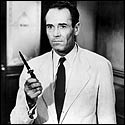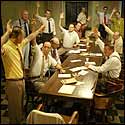1. Written by Reginald Rose after jury duty, the tense teleplay debuts in 1954 on NBC. One juror, voting not guilty on murder (by switchblade; how quaint!), slowly persuades the others to acquit—making the case for courtroom TV.

2.Three years later, Sidney Lumet transfers it to film, starring Henry Fonda as the lone-wolf Juror No. 8. Fonda also produces, for the first and last time. Lumet, Rose, and the film are nominated for Oscars.
3. Rose writes stage version in 1964. Many an Off–Off Broadway, West End, and regional production will follow (including one with an all-stand-up-comic cast at the 2003 Edinburgh Festival Fringe); the play also serves as high-school civics text.
4. Civic-minded Dick Wolf debuts Law & Order in the fall of 1990. A year later, Court TV is launched, paving the way for O.J. et al. New York courtrooms begin to populate TV drama.
5. Inspired by the Simpson trial, William Friedkin updates Rose’s play (with the 76-year-old writer’s help) in 1997, making the most racist juror a black man. George C. Scott is the angry holdout, Jack Lemmon the lone wolf, Tony Danza the guy who just wants to get to the ball game.

6. In 2000, director Scott Ellis starts mulling a Broadway turn for Twelve Angry Men. He finds the script used for most regional productions “not very good,” but tracks down another Rose revision, written for a 1996 London production directed by Harold Pinter.
7. Summer 2004, and courtrooms own prime time. Though both The Jury (“Twelve Angry Men on acid”) and a jury documentary tank, L&O: Trial by Jury is set for spring. And Twelve Angry Men finally goes Broadway, with Boyd Gaines and Philip Bosco. Playwright Rose, alas, isn’t around to see it: He died in 2002.